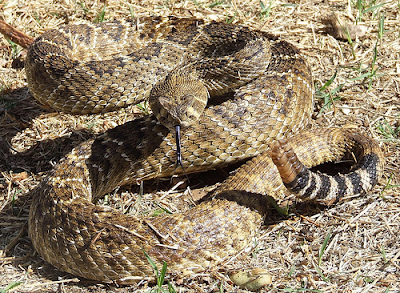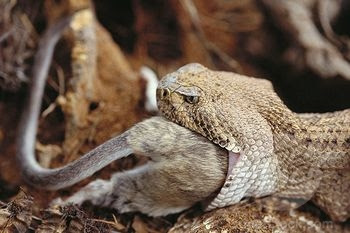This species of rattlesnake is famous all over the world for its appearance in countless cowboy films. It produces its sinister, dry rattling sound by vibrating the loose, horny rings on the end of its tail. Although this is a warning signal, the rattlesnake does not always rattle before striking.
 |
| The western diamondback rattlesnake |
Snakes and humans
Rattlesnakes are herded together each year in the Southern states of the USA during special 'round-ups'. Huge numbers of snakes are collected, and then butchered, skinned and eaten.
The snakes are brought to the round up in crates and transferred into large large pits for selection.They are often left in the crate for days.
Round-ups were originally thought of as a way of ridding public places of these potentially dangerous snakes, but collectors now travel far and wide to kill them.
What does a rattlesnake eat?
 |
| The western diamondback rattlesnake |
When hunting, the rattlesnake either sits and waits under a bush for a victim to pass by, or actively searches for prey by investigating burrows, plants and crevices.
It hunts using a combination of sight, smell and heat detection and can even track down prey in complete darkness.
Although, like all snakes, the rattlesnakes does not have ears, it can sense slight variations in temperature and can 'feel' the vibrations of animals moving nearby through its body.
Rattlesnake reproduction
 |
| The western diamondback rattlesnake |
Giving birth to young in this way is called ovoviviparity. This enables the young to be protected form the extremes of temperatures before they are born.
There is no eggshell as such, only a thin membrane which either bursts when the young emerge or which the young have to break through.
The size of the brood depends on the size of the female, but can contain up to 24 young - each about 30 cm long.
Rattlesnake facts
 |
| The western diamondback rattlesnakes |
A new segment is added each time the snakes sheds its skin, and they fit over each other in a chain. This is attached to the body by a small 'button'. When the snake reaches full size, its rattle ceases to grow as old segments tend to drop off at the same rate as new ones develop.
2. More people in the USA are bitten by the western diamondback than any other rattlesnake, but the Mojave rattlesnake is 20 times more lethal.
3. The western diamondback rattlesnake is an agile swimmer and will pursue its prey through water.
4. The rattlesnake performs a kind of dance which was thought to be a courtship ritual. It is now known to be a combat or trial of strength between rival males, although they never harm one another.
5. The western diamondback rattlesnake can reach an overall length of up to 7 feet, and can live up to 15 - 20 years in captivity.
For related articles click onto:
DIAMONDBACK RATTLESNAKE
RATTLESNAKE BITE
WHAT IS THE BIGGEST SNAKE IN THE WORLD?
WHAT IS THE WORLD'S MOST POISONOUS SNAKE?
WHAT IS THE MOST VENOMOUS SNAKE IN AMERICA?
WHAT IS THE MOST POISONOUS SNAKE IN INDIA?







No comments:
Post a Comment